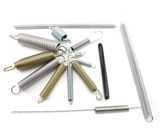Helical extension springs are critical components for the proper functioning of many devices that are used in a wide array of industrial, commercial, and domestic products. Unlike other spring designs, extension springs exert force based on the principle of tension, a measurable force that derives its energy from pulling, stretching, or elongation.
 In extension spring design, engineers must consider several factors to ensure the design specification meets the application requirements, such as the spring’s shape and end type, the number of coils needed, and the preload and allowable stress. More importantly, during the design phase, the exact load requirements for the spring must be accurately calculated to ensure the long-term performance of the device.
In extension spring design, engineers must consider several factors to ensure the design specification meets the application requirements, such as the spring’s shape and end type, the number of coils needed, and the preload and allowable stress. More importantly, during the design phase, the exact load requirements for the spring must be accurately calculated to ensure the long-term performance of the device.
Manufactured from a variety of spring wire materials, extension springs are used in garage door assemblies, automobile suspensions, washing machines, medical devices, farm machinery, carburetors, specific OEM products and much more. They feature specifically designed loops or hooks on each end of the spring for easy attachment to other components within a mechanical assembly. When the components are pulled apart, the spring expands, resistance grows, and tension mounts against the pulling force where the mechanical energy within the spring’s coil is stored. Once the pulling force is released, the spring releases its mechanical energy and returns to its original position within the assembly.
For a helical extension spring then, its potential mechanical energy is stored in the coil and released when it is pulled or stretched—the tighter the coil, the greater resistance and tensile force when elongated. The tightly wound coils have no pitch between them when an extension spring is at rest. In fact, when visible signs of pitch appear between the coils it means the spring’s service life has ended.
How Extension Springs are Calculated
Helical extension spring design software helps engineers avoid the tedious task of manually calculating formulas and equations necessary for extension spring design. Extension spring design software accurately calculates spring design specifications such as spring rate or constant, safe maximum deflection, safe maximum loads, maximum safe travel, and other specifications based on the physical dimension requirements for an application, such as the wire diameter, outer diameter, type of hooks, length inside hooks, and the type of material. The software can be used to calculate the loaded height or the amount of load needed for an application. It also allows for the calculation of different material types and their properties, such as tensile strengths, that are required for an application.
Important Extension Spring Design Considerations
Helical extension spring design considerations can vary, but of primary concern would be the end configuration,, the spring’s shape and size, the type of material and the material properties required, and any particular surface treatment or plating to ensure optimal component performance.
The ends of extension springs are manufactured to meet the specification requirements of an application. End designs come in a variety of sizes and configurations—straight-cut, loop, side loop, double full loop, machine hook, and extended hook are a few common examples. For design considerations, specific end configurations determine how each end of the extension spring attaches to another component. They must be of a size and shape to support the load and store the necessary potential energy until released.
Selecting the right material for extension springs is another design consideration. The wire material must have the mechanical properties to meet the performance requirements of the device or product under numerous conditions and environments. It may require ductility, durability, conductivity, fatigue resistance or high tensile strength. For example, the spring may be subjected to moisture and corrosion, extreme temperatures, constant vibration, exposure, or high impact and the material must have the properties to withstand such conditions.
There are a variety of wire materials available to meet specific extension spring design requirements. The list would include Stainless Steel (17-7 SS, 302 SS, 304 SS, 316 SS, & 316L SS), Music Wire, Beryllium Copper, Chrome Silicon, Chrome Vanadium, Oil Tempered, Phosphor Bronze, Titanium, Elgiloy, Hard Drawn Wire, Hastelloy, Inconel, Monel, MP35N, and Nitinol.
Finally, surface treatment and plating requirements are another extension spring design consideration. Common surface treatments are anodizing, bead blasting, citric and nitric passivation, color coding, electro polish, powder coating, and zinc plate. Black oxide, cadmium, chrome, gold, nickel, phosphate, tin, and zinc are common plating options.
Custom Extension Spring Design
James Spring and Wire Company has successfully partnered with fabricators, engineers, and design firms alike in the design and manufacture of custom extension springs. Our in-house engineering department can help you with your extension spring design to ensure that your design specifications are met and the best, quality spring is manufactured for your application. To learn more about how we can help you with extension spring design, contact James Spring and Wire today.

